technical data FIAT STILO 2006 1.G Owners Manual
[x] Cancel search | Manufacturer: FIAT, Model Year: 2006, Model line: STILO, Model: FIAT STILO 2006 1.GPages: 274, PDF Size: 4.76 MB
Page 27 of 274
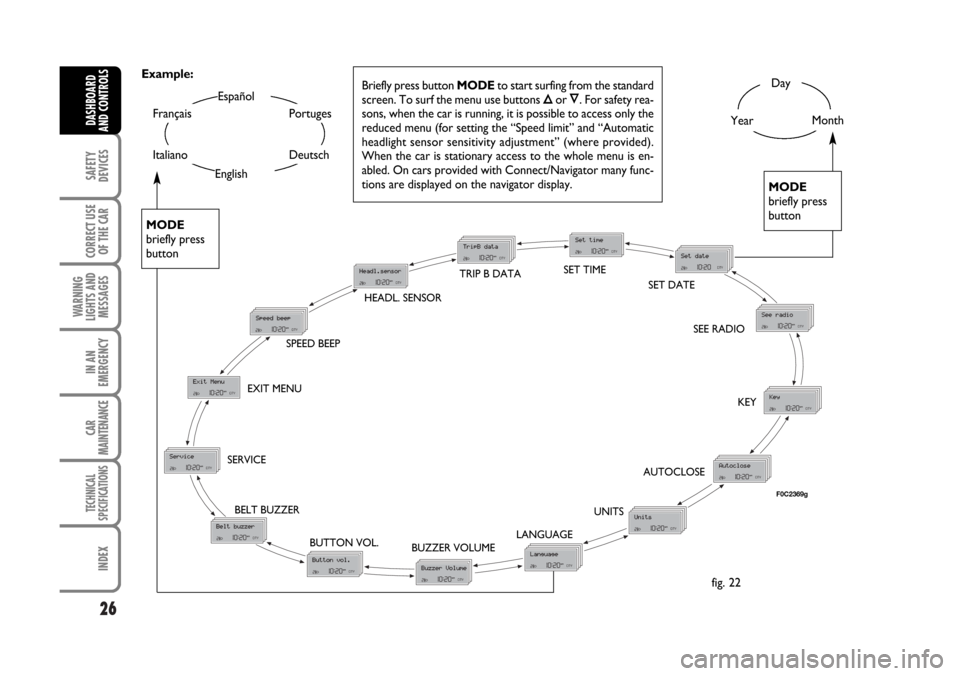
26
SAFETY
DEVICES
CORRECT USE
OF THE CAR
WARNING
LIGHTS AND
MESSAGES
IN AN
EMERGENCY
CAR
MAINTENANCE
TECHNICAL
SPECIFICATIONS
INDEX
DASHBOARD
AND CONTROLS
Day
YearMonth
Español
English
Portuges
Deutsch
Français
Italiano
EXIT MENUTRIP B DATASET TIME
SET DATE
SEE RADIO
KEY
AUTOCLOSE
UNITS
LANGUAGE
BUZZER VOLUME BUTTON VOL. BELT BUZZER SERVICESPEED BEEP
Briefly press button MODEto start surfing from the standard
screen. To surf the menu use buttons Õor Ô. For safety rea-
sons, when the car is running, it is possible to access only the
reduced menu (for setting the “Speed limit” and “Automatic
headlight sensor sensitivity adjustment” (where provided).
When the car is stationary access to the whole menu is en-
abled. On cars provided with Connect/Navigator many func-
tions are displayed on the navigator display.
MODE
briefly press
button
MODE
briefly press
button
Example:
fig. 22
HEADL. SENSOR
F0C2369g
Page 29 of 274
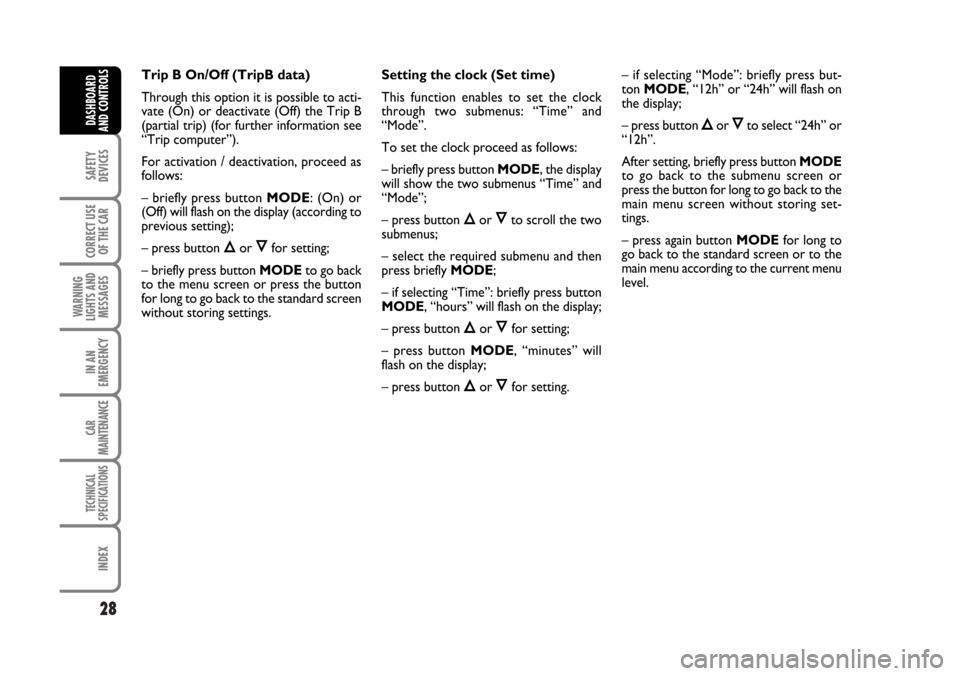
28
SAFETY
DEVICES
CORRECT USE
OF THE CAR
WARNING
LIGHTS AND
MESSAGES
IN AN
EMERGENCY
CAR
MAINTENANCE
TECHNICAL
SPECIFICATIONS
INDEX
DASHBOARD
AND CONTROLS
Trip B On/Off (TripB data)
Through this option it is possible to acti-
vate (On) or deactivate (Off) the Trip B
(partial trip) (for further information see
“Trip computer”).
For activation / deactivation, proceed as
follows:
– briefly press button MODE: (On) or
(Off) will flash on the display (according to
previous setting);
– press button
Õor Ôfor setting;
– briefly press button MODEto go back
to the menu screen or press the button
for long to go back to the standard screen
without storing settings.Setting the clock (Set time)
This function enables to set the clock
through two submenus: “Time” and
“Mode”.
To set the clock proceed as follows:
– briefly press button MODE, the display
will show the two submenus “Time” and
“Mode”;
– press button
Õor Ôto scroll the two
submenus;
– select the required submenu and then
press briefly MODE;
– if selecting “Time”: briefly press button
MODE, “hours” will flash on the display;
– press button
Õor Ôfor setting;
– press button MODE, “minutes” will
flash on the display;
– press button
Õor Ôfor setting.– if selecting “Mode”: briefly press but-
ton MODE, “12h” or “24h” will flash on
the display;
– press button
Õor Ôto select “24h” or
“12h”.
After setting, briefly press button MODE
to go back to the submenu screen or
press the button for long to go back to the
main menu screen without storing set-
tings.
– press again button MODEfor long to
go back to the standard screen or to the
main menu according to the current menu
level.
Page 52 of 274
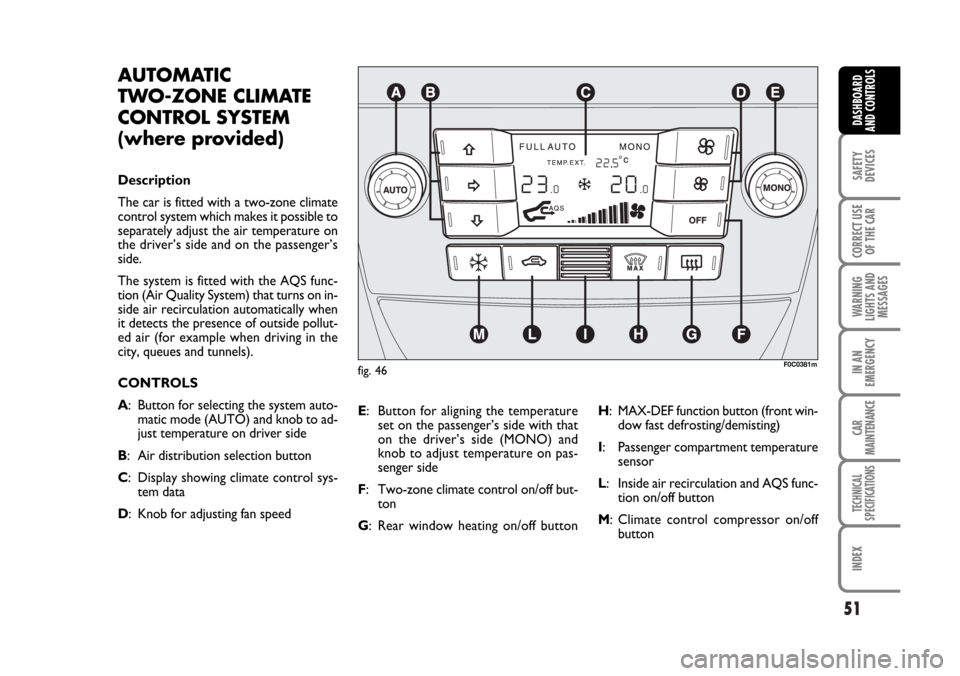
51
SAFETY
DEVICES
CORRECT USE
OF THE CAR
WARNING
LIGHTS AND
MESSAGES
IN AN
EMERGENCY
CAR
MAINTENANCE
TECHNICAL
SPECIFICATIONS
INDEX
DASHBOARD
AND CONTROLS
F0C0381mfig. 46
AUTOMATIC
TWO-ZONE CLIMATE
CONTROL SYSTEM
(where provided)
Description
The car is fitted with a two-zone climate
control system which makes it possible to
separately adjust the air temperature on
the driver’s side and on the passenger’s
side.
The system is fitted with the AQS func-
tion (Air Quality System) that turns on in-
side air recirculation automatically when
it detects the presence of outside pollut-
ed air (for example when driving in the
city, queues and tunnels).
CONTROLS
A: Button for selecting the system auto-
matic mode (AUTO) and knob to ad-
just temperature on driver side
B: Air distribution selection button
C: Display showing climate control sys-
tem data
D: Knob for adjusting fan speedE: Button for aligning the temperature
set on the passenger’s side with that
on the driver’s side (MONO) and
knob to adjust temperature on pas-
senger side
F: Two-zone climate control on/off but-
ton
G: Rear window heating on/off buttonH: MAX-DEF function button (front win-
dow fast defrosting/demisting)
I: Passenger compartment temperature
sensor
L: Inside air recirculation and AQS func-
tion on/off button
M: Climate control compressor on/off
button
Page 109 of 274
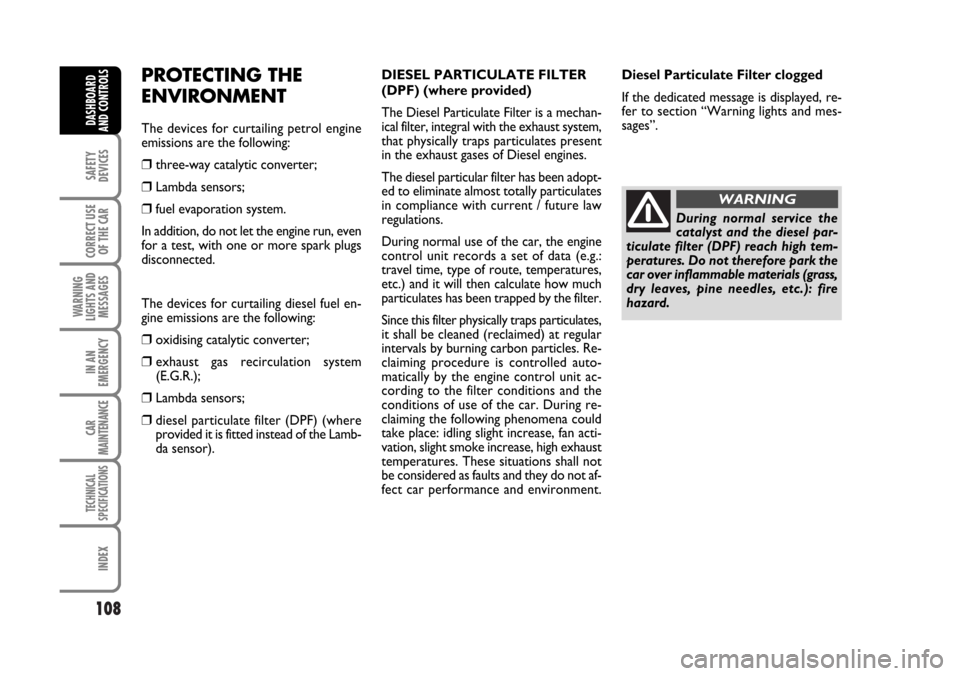
108
SAFETY
DEVICES
CORRECT USE
OF THE CAR
WARNING
LIGHTS AND
MESSAGES
IN AN
EMERGENCY
CAR
MAINTENANCE
TECHNICAL
SPECIFICATIONS
INDEX
DASHBOARD
AND CONTROLS
Diesel Particulate Filter clogged
If the dedicated message is displayed, re-
fer to section “Warning lights and mes-
sages”.
During normal service the
catalyst and the diesel par-
ticulate filter (DPF) reach high tem-
peratures. Do not therefore park the
car over inflammable materials (grass,
dry leaves, pine needles, etc.): fire
hazard.
WARNING
PROTECTING THE
ENVIRONMENT
The devices for curtailing petrol engine
emissions are the following:
❒ three-way catalytic converter;
❒Lambda sensors;
❒fuel evaporation system.
In addition, do not let the engine run, even
for a test, with one or more spark plugs
disconnected.
The devices for curtailing diesel fuel en-
gine emissions are the following:
❒oxidising catalytic converter;
❒ exhaust gas recirculation system
(E.G.R.);
❒Lambda sensors;
❒diesel particulate filter (DPF) (where
provided it is fitted instead of the Lamb-
da sensor).DIESEL PARTICULATE FILTER
(DPF) (where provided)
The Diesel Particulate Filter is a mechan-
ical filter, integral with the exhaust system,
that physically traps particulates present
in the exhaust gases of Diesel engines.
The diesel particular filter has been adopt-
ed to eliminate almost totally particulates
in compliance with current / future law
regulations.
During normal use of the car, the engine
control unit records a set of data (e.g.:
travel time, type of route, temperatures,
etc.) and it will then calculate how much
particulates has been trapped by the filter.
Since this filter physically traps particulates,
it shall be cleaned (reclaimed) at regular
intervals by burning carbon particles. Re-
claiming procedure is controlled auto-
matically by the engine control unit ac-
cording to the filter conditions and the
conditions of use of the car. During re-
claiming the following phenomena could
take place: idling slight increase, fan acti-
vation, slight smoke increase, high exhaust
temperatures. These situations shall not
be considered as faults and they do not af-
fect car performance and environment.
Page 117 of 274
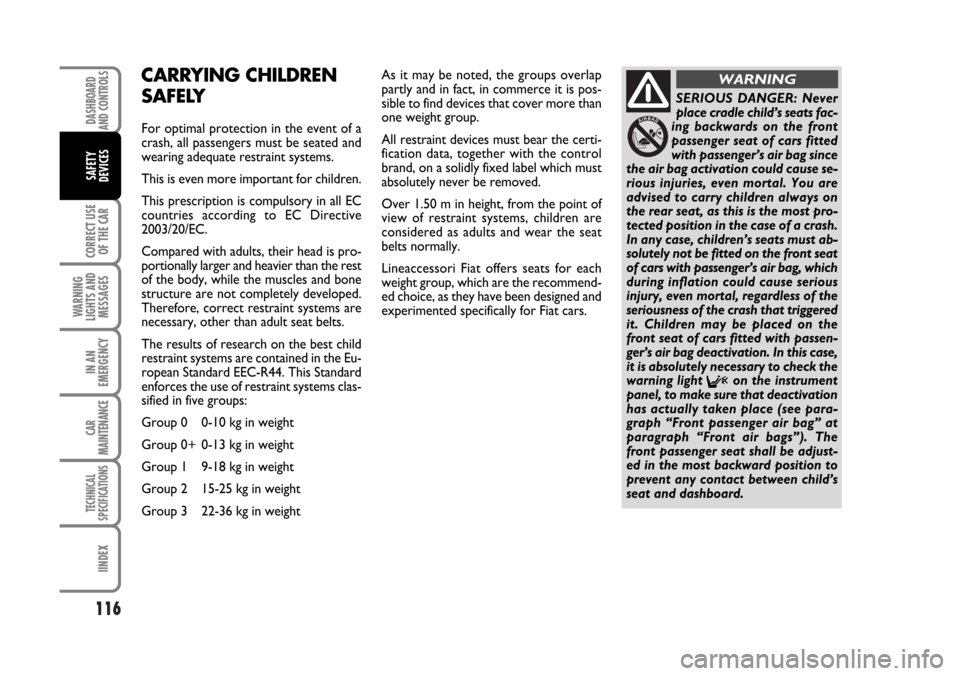
116
CORRECT USE
OF THE CAR
WARNING
LIGHTS AND
MESSAGES
IN AN
EMERGENCY
CAR
MAINTENANCE
TECHNICAL
SPECIFICATIONS
IINDEX
DASHBOARD
AND CONTROLS
SAFETY
DEVICES
SERIOUS DANGER: Never
place cradle child’s seats fac-
ing backwards on the front
passenger seat of cars fitted
with passenger’s air bag since
the air bag activation could cause se-
rious injuries, even mortal. You are
advised to carry children always on
the rear seat, as this is the most pro-
tected position in the case of a crash.
In any case, children’s seats must ab-
solutely not be fitted on the front seat
of cars with passenger’s air bag, which
during inflation could cause serious
injury, even mortal, regardless of the
seriousness of the crash that triggered
it. Children may be placed on the
front seat of cars fitted with passen-
ger’s air bag deactivation. In this case,
it is absolutely necessary to check the
warning light
Fon the instrument
panel, to make sure that deactivation
has actually taken place (see para-
graph “Front passenger air bag” at
paragraph “Front air bags”). The
front passenger seat shall be adjust-
ed in the most backward position to
prevent any contact between child’s
seat and dashboard.
WARNINGCARRYING CHILDREN
SAFELY
For optimal protection in the event of a
crash, all passengers must be seated and
wearing adequate restraint systems.
This is even more important for children.
This prescription is compulsory in all EC
countries according to EC Directive
2003/20/EC.
Compared with adults, their head is pro-
portionally larger and heavier than the rest
of the body, while the muscles and bone
structure are not completely developed.
Therefore, correct restraint systems are
necessary, other than adult seat belts.
The results of research on the best child
restraint systems are contained in the Eu-
ropean Standard EEC-R44. This Standard
enforces the use of restraint systems clas-
sified in five groups:
Group 0 0-10 kg in weight
Group 0+ 0-13 kg in weight
Group 1 9-18 kg in weight
Group 2 15-25 kg in weight
Group 3 22-36 kg in weightAs it may be noted, the groups overlap
partly and in fact, in commerce it is pos-
sible to find devices that cover more than
one weight group.
All restraint devices must bear the certi-
fication data, together with the control
brand, on a solidly fixed label which must
absolutely never be removed.
Over 1.50 m in height, from the point of
view of restraint systems, children are
considered as adults and wear the seat
belts normally.
Lineaccessori Fiat offers seats for each
weight group, which are the recommend-
ed choice, as they have been designed and
experimented specifically for Fiat cars.
Page 238 of 274
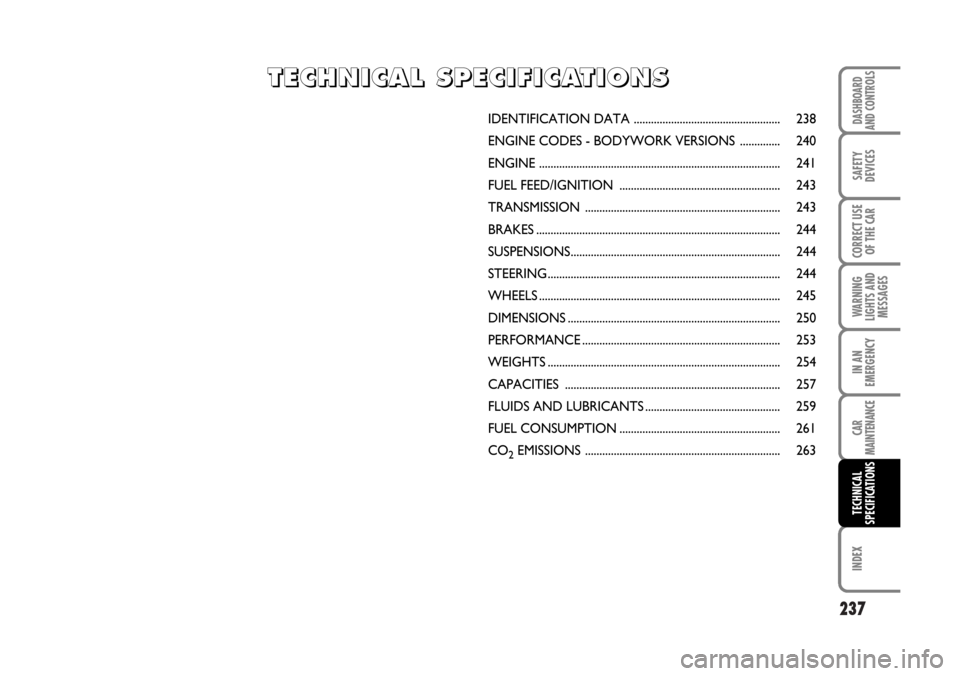
237
WARNING
LIGHTS AND
MESSAGES
INDEX
DASHBOARD
AND CONTROLS
SAFETY
DEVICES
CORRECT USE
OF THE CAR
IN AN
EMERGENCY
CAR
MAINTENANCE
TECHNICAL
SPECIFICATIONS
IDENTIFICATION DATA ................................................... 238
ENGINE CODES - BODYWORK VERSIONS .............. 240
ENGINE .................................................................................... 241
FUEL FEED/IGNITION ........................................................ 243
TRANSMISSION .................................................................... 243
BRAKES ..................................................................................... 244
SUSPENSIONS......................................................................... 244
STEERING ................................................................................. 244
WHEELS .................................................................................... 245
DIMENSIONS .......................................................................... 250
PERFORMANCE ..................................................................... 253
WEIGHTS ................................................................................. 254
CAPACITIES ........................................................................... 257
FLUIDS AND LUBRICANTS ............................................... 259
FUEL CONSUMPTION ........................................................ 261
CO
2EMISSIONS .................................................................... 263
T T
E E
C C
H H
N N
I I
C C
A A
L L
S S
P P
E E
C C
I I
F F
I I
C C
A A
T T
I I
O O
N N
S S
Page 239 of 274
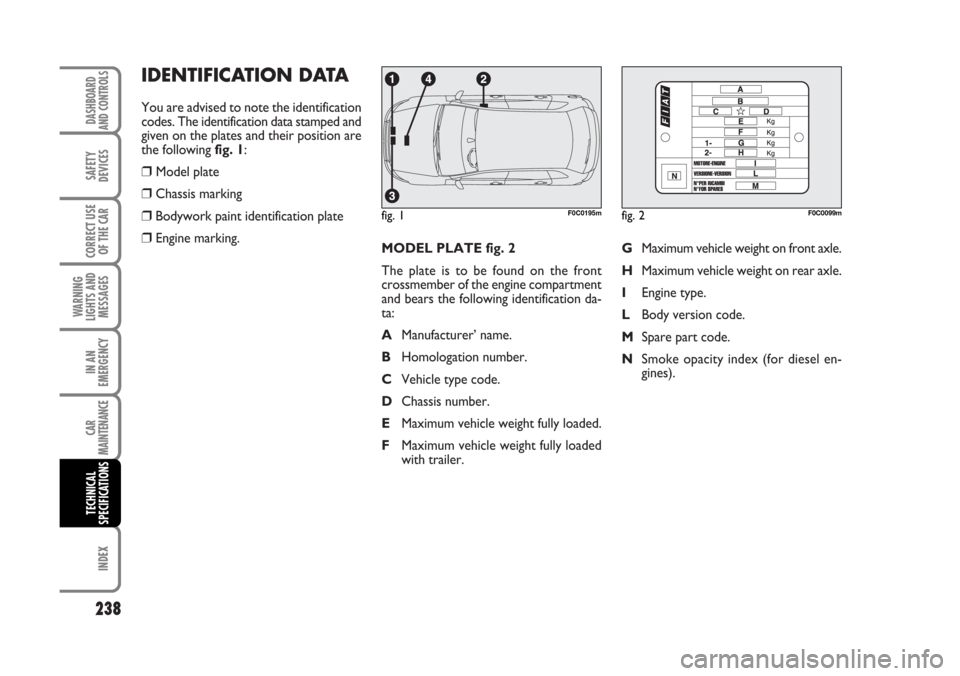
MODEL PLATE fig. 2
The plate is to be found on the front
crossmember of the engine compartment
and bears the following identification da-
ta:
AManufacturer’ name.
BHomologation number.
CVehicle type code.
DChassis number.
EMaximum vehicle weight fully loaded.
FMaximum vehicle weight fully loaded
with trailer.GMaximum vehicle weight on front axle.
HMaximum vehicle weight on rear axle.
IEngine type.
LBody version code.
MSpare part code.
NSmoke opacity index (for diesel en-
gines).
IDENTIFICATION DATA
You are advised to note the identification
codes. The identification data stamped and
given on the plates and their position are
the following fig. 1:
❒ Model plate
❒Chassis marking
❒Bodywork paint identification plate
❒Engine marking.
238
WARNING
LIGHTS AND
MESSAGES
INDEX
DASHBOARD
AND CONTROLS
SAFETY
DEVICES
CORRECT USE
OF THE CAR
IN AN
EMERGENCY
CAR
MAINTENANCE
TECHNICAL
SPECIFICATIONS
fig. 1F0C0195mfig. 2F0C0099m
Page 240 of 274
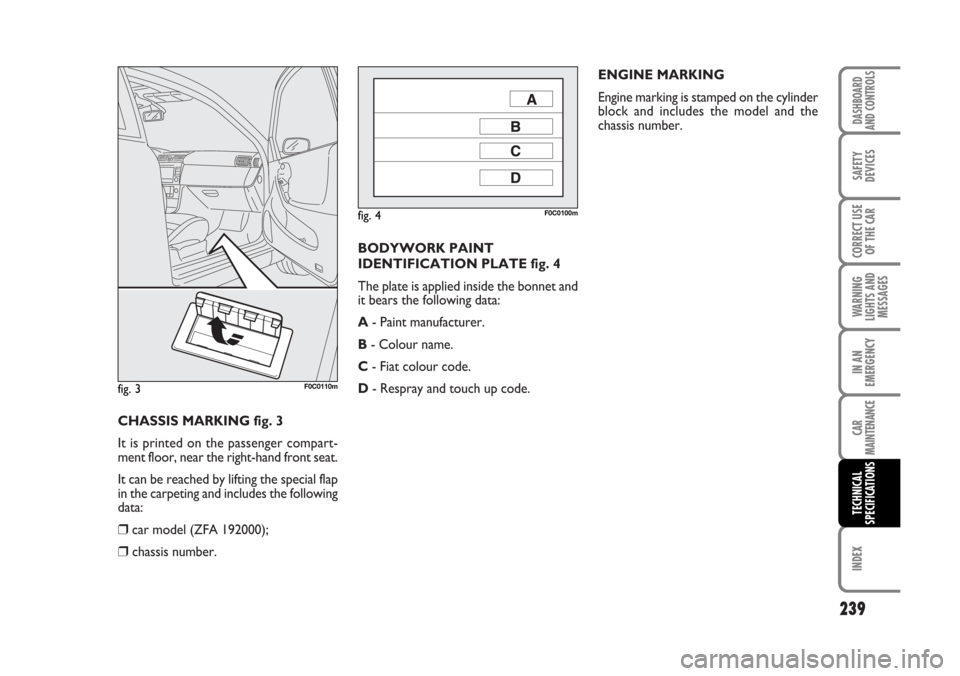
BODYWORK PAINT
IDENTIFICATION PLATE fig. 4
The plate is applied inside the bonnet and
it bears the following data:
A- Paint manufacturer.
B- Colour name.
C- Fiat colour code.
D- Respray and touch up code.ENGINE MARKING
Engine marking is stamped on the cylinder
block and includes the model and the
chassis number.
CHASSIS MARKING fig. 3
It is printed on the passenger compart-
ment floor, near the right-hand front seat.
It can be reached by lifting the special flap
in the carpeting and includes the following
data:
❒car model (ZFA 192000);
❒ chassis number.
239
WARNING
LIGHTS AND
MESSAGES
INDEX
DASHBOARD
AND CONTROLS
SAFETY
DEVICES
CORRECT USE
OF THE CAR
IN AN
EMERGENCY
CAR
MAINTENANCE
TECHNICAL
SPECIFICATIONS
fig. 4F0C0100m
fig. 3F0C0110m
Page 266 of 274

265
WARNING
LIGHTS AND
MESSAGES
DASHBOARD
AND CONTROLS
SAFETY
DEVICES
CORRECT USE
OF THE CAR
IN AN
EMERGENCY
CAR
MAINTENANCE
TECHNICAL
SPECIFICATIONS
INDEX
Gearbox
– using manual gearbox .................. 140
– using Selespeed gearbox ............. 141
Glass holder .......................................... 73
Glove box light
(bulb replacement) ............................ 194
Glove box/oddment
compartments ................................... 71
Handbrake ........................................... 139
Hazard lights ......................................... 68
Head restraints ..................................... 41
Headlight washer .................................. 65
Headlights ............................................... 94
Heating and ventilation system ..44-46
Identification data ............................... 238
If an exterior light burns out ............. 184
If an interior light burns out .............. 192
Ignition switch ...................................... 20
In an emergency............................. 169
Independent additional heater ......... 56
Installation of electric/
electronic devices .............................. 101
Instrument panel ................................. 6
Instruments ........................................... 21
Interior fittings ..................................... 70
Interiors ................................................. 235Isofix (child restraint system) ........... 121
Jacking the car ..................................... 206
Keys ....................................................... 10
Load limiters ....................................... 113
Main beam headlights......................... 59
MSR (system) ....................................... 99
Multifunction display ........................... 23
Number plate lights
(bulb replacement) ............................ 191
OCS
(Occupant Classification System) .. 129
Oddment compartments .................. 73
Paint ...................................................... 233
Parking ................................................... 139
Parking lights ......................................... 69
Parking sensors .................................... 103
Performance ......................................... 253
Pollen filter ............................................ 225
Power windows ................................... 80
Presetting for mounting the
“Isofix ” child restraint system ...... 121 Electric power steering “Dualdrive” .. 102
Electronic alarm ................................... 17
Engine
– identification code ........................ 240
– technical data ......................... 241-242
Engine compartment
– washing ............................................ 234
Engine oil
– consumption .................................. 220
Environment protection .................... 108
EOBD (system) .................................... 99
ESP (system) ......................................... 97
External lights ....................................... 59
Fiat CODE (system) .......................... 8
Fire extinguisher .................................. 208
Fix&Go automatic ............................... 177
Flashing the headlights ........................ 59
Fluid level checks ................................. 216
Fluids and lubricants ........................... 259
Follow me home (device) ................. 60
Front fog lights ............................... 68-69
– (bulb replacement)......................... 186
Fuel consumption ................................. 261
Fuel feed/ignition ................................. 241
Fuel filler cap ........................................ 106
Fuses (replacement) ........................... 196